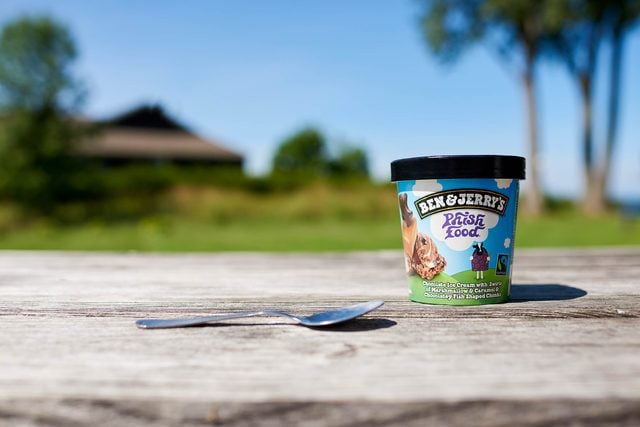The Real Reason Ben & Jerry’s Tastes So Good
Updated: Feb. 01, 2023
It involves a secret ingredient you never knew about.

The first scoops of Ben & Jerry’s ice cream were sold out of a renovated Vermont gas station in 1978. Now, it’s one of the most popular ice cream brands in America (it raked in over $477 million in sales in 2017 alone).
You’d be hard-pressed to find someone who doesn’t enjoy Ben & Jerry’s creamy treats, but why do they taste so good in the first place? After all, ice cream is ice cream, right?
Technically, yes. All ice cream starts with the same basic ingredients: sugar, cream, and milk. But there’s one “ingredient” that separates everyday ice cream from the premium, high-quality kind—and you’re breathing it right now.
Believe it or not, air is a huge factor in determining the overall quality of any ice cream. The dairy industry uses the term “overrun” to indicate the volume of air pumped into ice cream while it’s being manufactured relative to the base mixture. This aeration, as the International Dairy Foods Association so eloquently puts it, “keeps the mixture from becoming an inedible frozen mass.”
If you’re a fan of Ben & Jerry’s, you like ice cream with low overrun. A low overrun means less air content and more room for butterfat (the fat from milk and dairy products), leaving you with richer, denser ice cream. The FDA has set overrun standards so companies can’t sell you ice cream that is literally half air, and it has also classified ice cream based on the amount of overrun it contains. Here’s the breakdown:
Economy: With at least 10 percent butterfat and less than 100 percent overrun, economy ice cream meets the most basic requirements for the FDA’s standards and is generally the cheapest.
Regular: This type of ice cream also meets federal standards for ice cream, while still a step up from economy, and is the ice cream you’ll see most often in grocery store freezers.
Premium: Here’s where brands like Ben & Jerry’s and Häagen Dazs fit in. They have less than 50 percent overrun, a higher percentage of butterfat (11-15 percent, according to the Institute of Culinary Education), and higher quality ingredients.
Super premium: These ice creams have even lower overrun (as low as 20 percent) and more butterfat (between 14 and 18 percent) than premium kinds and they’re most commonly found in high-end restaurants. Superpremium ice creams may also be made in the French style of ice cream, which includes egg yolks.
So the next time you take a spoonful of your favorite Ben & Jerry’s flavor, thank its manufacturers for going easy on the air. Next, read up on these 50 secrets food manufacturers aren’t telling you.